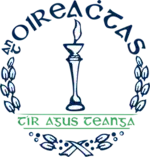Oireachtas na Gaeilge
Oireachtas na Gaeilge (Irish pronunciation: [ˈɛɾʲəxt̪ˠəsˠ n̪ˠə ˈɡeːlʲɟə], “The Irish (language) Gathering”) is an annual arts festival of Irish culture, which has run since the 1890s. Inspired by the Welsh eisteddfodau,[1] the festival has included different events connected with Irish language and culture over the years. Today the festival organisation runs events throughout the year, but the most prominent is Oireachtas na Samhna (“the November gathering”) held on the last weekend of October or the first of November, when more than 100,000 people attend the seven-day event.

History
The first Oireachtas na Gaeilge festival was organised in 1897 by Conradh na Gaeilge (the Gaelic League), which envisaged it as part of a renaissance of traditional Irish arts and culture.[2] in the Round Room of Dublin's Rotunda, one of the largest halls in the city at that time. It was just a half-day festival, but the attendance still exceeded a thousand people, an unexpected level of interest.
In contrast to today's festival, there was little emphasis on the performing arts. The competitions included two for poetry, five for prose essays, one for poetry compilations; a competition for unpublished songs or stories in Irish; a competition for new song compositions and a recitation competition.
While the festival management pulled off accomplishments including the staging of the first Irish-language opera, the popularity of the Oireachtas waned in the early part of the twentieth century, and the festival was cancelled for a number of years in the 1920s and 1930s. In response, the organisers, under the Directorship of Liam Ó Maolaodha attempted from the 1990s on to market the festival to younger speakers of Irish via outings, discos, and other youth-oriented events.
The festival was originally held in Dublin, but since the 1970s, it has been held in different cities and towns around Ireland. The festival culminates in four major competitions over the weekend:
- Corn Uí Riada, a sean-nós singing competition for all age and gender categories,
- Comórtas na mBan, a sean-nós singing competition for women
- Comórtas na bhFear, a sean-nós singing competition for men,
- Comórtas Damhsa ar an Sean Nós ("Steip"), a free-style dancing competition
Although the majority of participants in Comórtas Damhsa ar an Sean Nós practice Conamara individual step style now popular around the country, the competition also includes dancing in other regional styles.
Past winners of Corn Uí Riada include Áine Uí Cheallaigh, Lillis Ó Laoire, Máirtín Tom Sheánín Mac Donnchadha, Mícheál Ó Confhaola and 2008 winner Ciarán Ó Con Cheanainn from An Spidéal, County Galway.
Venue
| Year | Venue | Notes |
|---|---|---|
| 2022 | Killarney | |
| 2020 | Galway | |
| 2019 | Dublin | |
| 2016–18 | Killarney | |
| 2015 | Dublin | |
| 2013–14 | Killarney | |
| 2012 | Letterkenny | |
| 2010–11 | Killarney | |
| 2009 | Letterkenny | |
| 2008 | Cork | |
| 2007 | Westport | |
| 2006 | Derry | |
| 2005 | Cork | |
| 2004 | Letterkenny | |
| 2003 | Tralee | |
| 2002 | Gweedore | |
| 2001 | Dingle | |
| 2000 | Castlebar | |
| 1999 | Dungarvan | |
| 1998 | Tralee | |
| 1997 | Belfast | |
| 1996 | Gweedore | |
| 1995 | Dublin | |
| 1994 | Dungarvan | |
| 1993 | Galway | |
| 1992 | Dingle | |
| 1991 | Dublin | |
| 1990 | Ennis | |
| 1989 | Glencolmcille | |
| 1988 | Tralee | |
| 1980 | Gweedore | |
| 1977 | Gweedore | |
| 1974 | Cois Fharraige | |
| 1939–1973 | Dublin | |
| 1924–1938 | no Oireachtas | |
| 1923 | Dublin | |
| 1920 | Dublin | |
| 1919 | Cork | |
| 1917 | Waterford | |
| 1915 | Dundalk | |
| 1914 | Killarney | |
| 1913 | Galway | |
| 1897–1912 | Dublin |
Media coverage
RTÉ Raidió na Gaeltachta has been covering the bigger Oireachtas events live since 1973 and these broadcasts are in considerable demand from internet audiences around the globe, particularly Corn Uí Riada and the sean-nós stage competitions. Steip, the Sean nós dancing competition, on TG4 has consistently attracted the station's highest annual audience figures. Its success is due to the hard work of Festival administrator Máirín Nic Dhonnchadha who effectively revived the competition from 2000 onwards. In 2008, for the first time, the station broadcast live segments of the Corn Uí Riada competition.
References
- De Barra, Caoimhín (May 2014). "A gallant little 'tírín': the Welsh influence on Irish cultural nationalism". Irish Historical Studies. 39 (153): 58–75. JSTOR 43654557 – via JSTOR.
- Ó hAllmhuráin, Gearóid (2017). A Short History of Irish Traditional Music. Dublin: The O'Brien Press. p. 55. ISBN 9781847179401.
- Ó Súilleabháin, Donncha (1984). Scéal an Oireachtais 1897 – 1924 (in Irish). Dublin: An Clóchomhar Tta.
- Ní Mhuiríosa, Máirín (1968). Réamhchonraitheoirí (in Irish). Dublin: Clódhanna Teo. ISBN 0-9501264-0-3.
- Mac Aonghusa, Proinsias (Ed.) (1997). Oireachtas na Gaeilge 1897 - 1997. Dublin: Conradh na Gaeilge.
- Mac Mathúna, Seán (1997). Cuimhní Cinn ar an Oireachtas (in Irish). Dublin: Conradh na Gaeilge.
External links
- Festival website
- An Irishwoman's Diary Preview in Irish Times 2008 by Catherine Foley